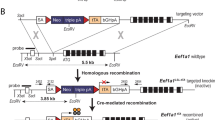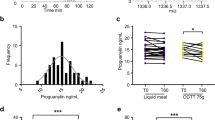Abstract
The ability of two mouse PRP gene promoters to direct the expression of the bacterial lacZ reporter gene was tested in transgenic mice. Transgenes A1-lacZ and C1-lacZ consisted of 8.2 kb A1 and 7.8 kb C1 PRP promoters respectively fused to the lacZ coding sequence. A1 and C1 are two A-type PRP genes isolated from the inbred SWR mice, which show the same gene structure and similar sequence to the closely related MP2 and M14 PRP genes previously cloned from outbred CD-1 mice. We here show that both A1-lacZ and C1-lacZ transgenes have very similar expression patterns: (1) they expressed the lacZ gene in all 14 established transgenic lines under normal (non-stimulated) conditions; (2) the expression was restricted to the granular convoluted tubular cells of the submandibular glands; (3) the expression was developmentally regulated beginning at sexual maturation and lasting to at least 1.5 years of age; and (4) expression in some lines was probably influenced by sex hormones, since higher expression was found in males than in females. A1-lacZ and C1- lacZ are the first transgenes derived from the PRP/GRP (glutamine/glutamic acid-rich protein) gene superfamily to be expressed in the granular convoluted tubular cells (with known endocrine functions), rather than in the acinar cells (with mainly exocrine functions) of the submandibular glands
Similar content being viewed by others
References
Ann, D.K. and Carlson D.M. (1985) The structure and organization of a proline-rich-protein gene of a mouse multigene family. J. Biol. Chem. 260, 15863-72.
Ann, D.K., Clements, S., Johnstone, E.M. and Carlson, D.M. (1987) Induction of tissue-specific proline-rich protein multigene families in rat and mouse parotids by isoproterenolunusual strain differences of proline-rich-protein mRNAs. J. Biol. Chem. 262, 899-904.
Ann, D.K., Smith, M.K. and Carlson, D.M. (1988) Molecular evolution of the mouse proline-rich-protein multigene family. J. Biol. Chem. 263, 10887-93.
Azen, E.A., Davisson, M.T., Cherry M. and Taylor, B.A. (1989) Prp (Proline-Rich-Protein) genes linked to markers Es-12 (Esterase-12), Ea-10 (Erythrocyte alloantigen), and loci on distal mouse chromosome 6. Genomics 5, 415-22.
Bennick, A. (1987) Structural and genetic aspects of proline-rich proteins. J. Dent. Res. 66, 457-61.
Brenner, M., Kisseberth, W.C., Su, Y., Besnard, F. and Messing, A. (1994) GFAP promoter directs astrocyte-specific expression in transgenic mice. J. Neurosci. 14, 1030-7.
Brinster, R.L., Chen, H.Y., Trumbauer, M.E., Yagle, M.K. and Palmiter, R.D. (1985) Factors affecting the efficiency of introducing foreign genes into mice by microinjecting eggs. Proc. Natl Acad. Sci. (USA) 82, 4438-42.
Carlson, D.M. (1993) Salivary proline-rich proteins: biochemistry, molecular biology, and regulation of expression. Critical Reviews in Oral Biol. and Med. 4, 495-502.
Courty, Y., Rosinski-Chupin, I. and Rougeon, F. (1994) A new proline-rich protein percursor expressed in the salivary glands of the rat is encoded by a gene homologous to the gene coding for the prohormone-like protein SMR1. J. Biol. Chem. 269, 520-7.
Divecha, N., Mansouri, H., Peat, D., Cope, G., Partridge, L. and McDonald, C.J. (1989) Isoprenaline-induced and constitutive members of a proline-rich protein sub-group from mouse parotid glands studied with monoclonal antibody NAL1. J. Mol. Endocrinol. 3, 7-14.
Gresik, E.W. (1994) The granular convoluted tubule (GCT) cell of rodent submandibular glands. Microscopy Res. Techniques 27, 1-24.
Heinrich, G. and Habener, J.F. (1987) Genes encoding proteins with homologous contiguous repeat sequences are highly expressed in the serous cells of the rat submandibular gland. J. Biol. Chem. 262, 5262-70.
Kain, S.R., Mai, K. and Sinai, P. (1994) Human multiple tissue Western lots: a new immunological tool for the analysis of tissue-specific protein expression. Biotechniques 17, 982-7.
Lazowski, K.W., Mertz, P.M., Redman, R.S., Ann, D.K. and Kousvelarl, E. (1992) Reciprocal expression of c-jun, prolinerich protein and amylase genes during rat parotid slivary gland development. Differentiation 51, 225-32.
Maeda, N., Kim, H.S., Azen, E.A. and Smithies, O. (1985) Differential RNA splicing and post-translational cleavages in the human salivary proline-rich protein gene system. J. Biol. Chem. 260, 11123-30.
Mansouri, H., Cope, G.H., Divecha, N. and McDonald, C.J. (1992) Electron microscopic immunocytochemical localization of proline-rich proteins in normal mouse parotid salivary glands. Histochem. J. 24, 737-46.
Mathison, R., Davison, J.S. and Befus, A.D. (1994) Neuroendocrine regulation of inflammation and tissue repair by submandibular gland factors. Immunol. Today 15, 527-32.
McCormick, A., Brady, H., Theill, L.E. and Karin, M. (1990) Regulation of the pituitary-specific homeobox gene GHF1 by cell-autonomous and environmental cues. Nature 345, 829-32.
Mehansho, H., Hagerman, A., Clements, S., Butler, L., Rogler, J. and Carlson, D.M. (1983) Modulation of proline-rich protein biosynthesis in rat parotid glands by sorghums with high tannin levels. Proc. Natl Acad. Sci. (USA). 80, 3948-52.
Mehansho, H., Clements, S., Sheares, B.T., Smith, S. and Carlson, D.M. (1985) Induction of proline-rich glycoprotein synthesis in mouse salivary glands by isoproterenol and by tannins. J. Biol. Chem. 260, 4418-23.
Mercer, E.H., Hoyle, G.W., Kapur, R.P., Brinster, R.L. and Palmiter, R.D. (1991) The dopamine beta-hydroxylase gene promoter directs expression of E. colilacZ to sympathetic and other neurons in adult transgenic mice. Neuron 7, 703-16.
Mikkelsen, T.R., Brandt, J., Larsen, H.J., Larsen, B.B., Poulsen, K., Ingerslev, J., Din, N. and Hjorth, J.P. (1992) Tissue-specific expression in the salivary glands of transgenic mice Nucleic Acids Res. 20, 2249-55.
Pascall, I.C., Surani, M.A., Barton, S.C., Vaughan, T.J. and Brown, D.K. (1994) Directed expression of simian virus 40 T-antigen in transgenic mice using the epidermal growth factor gene promoter. J. Mol. Endocrinol. 12, 313-25.
Penschow, J.D. and Coghlan, J.P. (1993) Secretion of glandular kallikrein and renin from the basolateral pole of mouse submandibular duct cells: an immunocytochemical study. J. Histochem. Cytochem. 41, 95-103.
Roberts, S.G.E., Layfield, R. and McDonald, C.J. (1991a) The mouse proline-rich protein MP6 promoter binds isoprenalineinducible parotid nuclear proteins via a highly conserved NFk/ rel-like site. Nucleic Acids Res. 19, 5205-11.
Roberts, S.G.E., Layfield, R., Bannister, A.J. and McDonald, C.J. (1991b) Gene sequence of mouse B-type proline-rich protein MP4. European J. Biochem. 202, 969-74.
Rosinski-Chupin, I., Rougeot, C., Courty, Y. and Rougeon, F. (1993) Localization of mRNAs of two androgen-dependent proteins, SMR1 and SMR2, by in situhybridization reveals sexual differences in acinar cells of rat submandibular gland. J. Histochem. Cytochem. 41, 1645-9.
Saiki, R.K., Scharf, S., Faloona, F., Mullis, K.B., Horn, G.T., Erlich, H.A. and Arnheim, N. (1985) Enzymatic amplification of beta-globin genomic sequences and restriction site analysis for diagnosis of sickle cell anemia. Science 230, 1350-4.
Sawada, K. and Noumura, T. (1991) Effects of castration and sex steroids on sexually dimorphic development of the mouse submandibular gland. Acta. Anat. 140, 97-103.
Son, H.J., Shahan, K., Rodriguez, M., Derman, E. and Costantini, F. (1991) Identification of an enhancer required for the expression of a mouse major urinary protein gene in the submaxillary gland. Mol. Cell. Biol. 11, 4244–52.
Tu, Z.J., Lazowski, K.W., Ehlenfeldt, R.G., Wu, G.P., Lin, H.H., Kousvelari, E. and Ann, D.K. (1993) Isoproterenol/tannindependent R15expression in transgenic mice is mediated by an upstream parotid control region. Gene Expression 3, 289-305.
Wright, P.S., Lenney, C. and Carlson, D.M. (1990) Regulation of proline-rich protein gene expression by cyclic AMP in primary cultures of hamster parotid glands. J. Mol. Endocrinol. 4, 81-7.
Ziemer, M.A., Swain, W.F., Rutter, W.J. Clements, S., Ann, D.K. and Carlson, D.M. (1984) Nucleotide sequence analysis of a proline-rich protein cDNA and peptide homologies of rat and human proline-rich proteins. J. Biol. Chem. 259, 10475-80.
Author information
Authors and Affiliations
Rights and permissions
About this article
Cite this article
Zhuo, L., Messing, A. & Azen, E.A. Proline-rich-protein promoters direct LacZ expression to the granular convoluted tubular cells of the submandibular gland in adult transgenic mice. Transgenic Res 6, 19–25 (1997). https://doi.org/10.1023/A:1018496814589
Issue Date:
DOI: https://doi.org/10.1023/A:1018496814589




